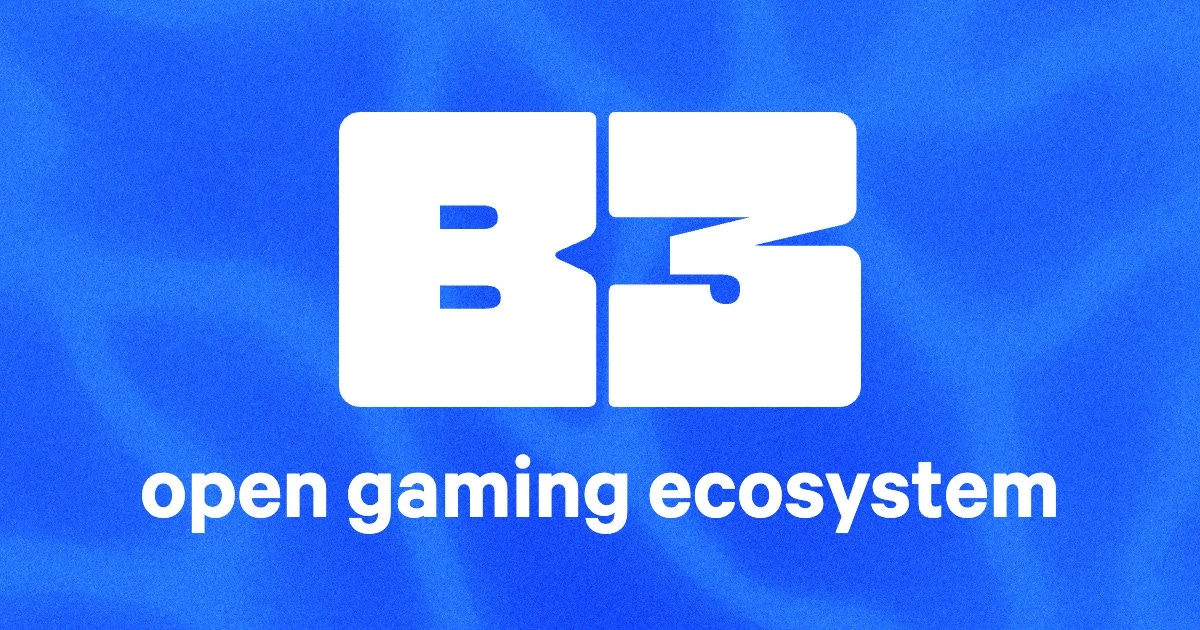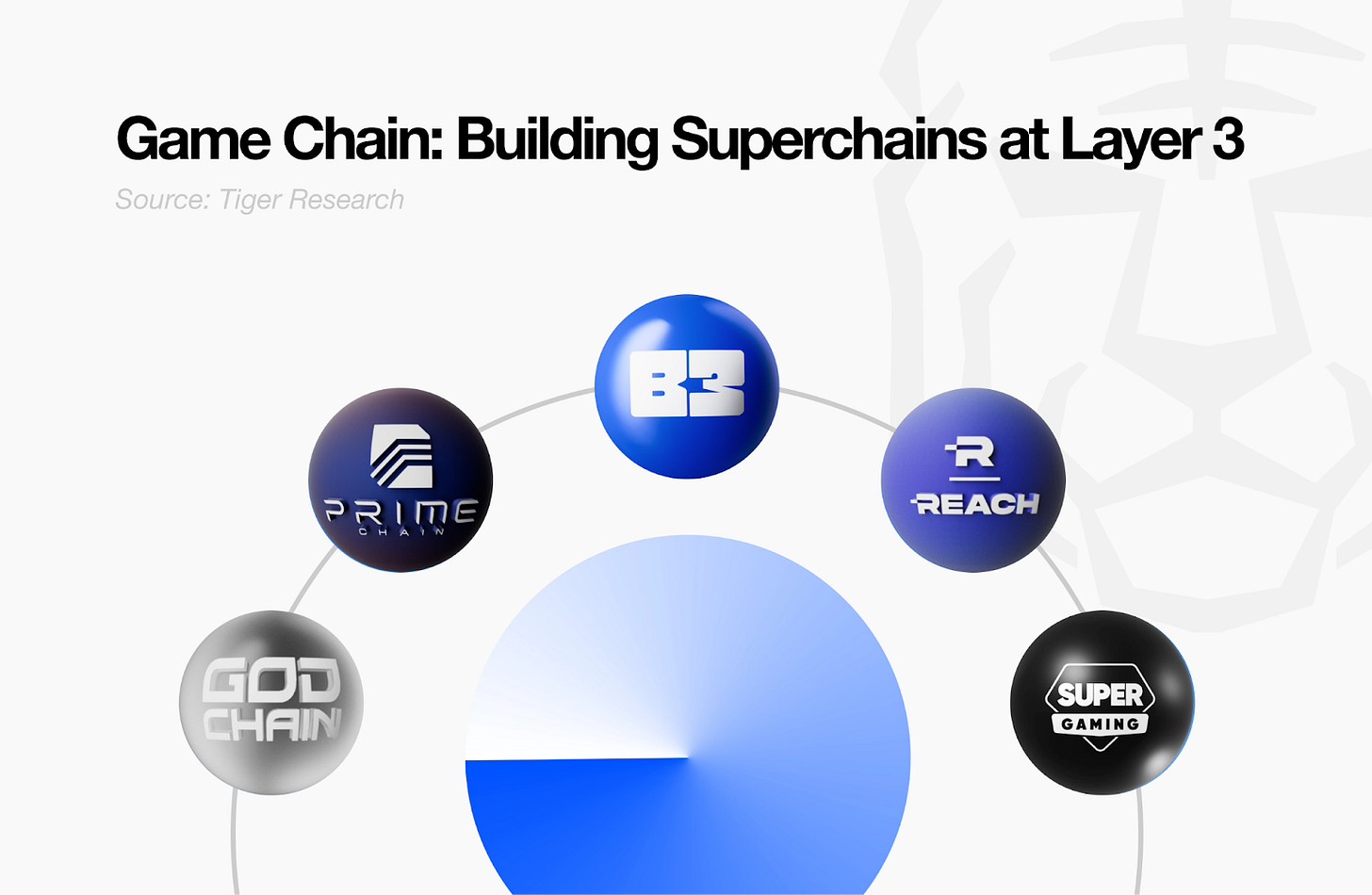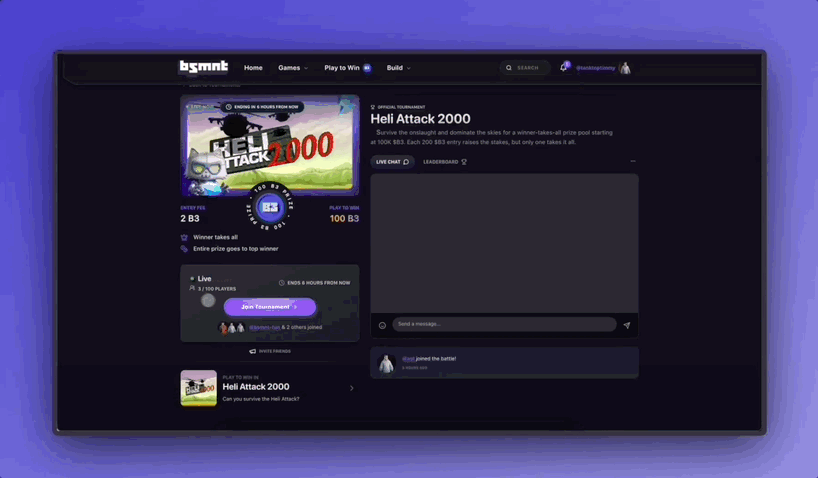The Open Gaming Manifesto: How B3 Will Save the Web3 Gaming Industry
When Everyone Unites, Everyone Wins the Game
This report was written by Tiger Research, analyzing how B3's Open Gaming Vision can solve practical problems in the Web3 gaming industry and its potential to expand into mainstream gaming markets.
🎤 Deep Dive with Our New Podcast
TL;DR
The Web3 gaming industry experiences a downturn after initial speculative fever. Critics point to closed ecosystem structures as a fundamental problem.
Former Coinbase employees and Base chain founding members created B3, a layer3 gaming infrastructure. This team develops high-performance, low-cost infrastructure optimized for the gaming industry. They build an open gaming ecosystem based on high interoperability to overcome the structural limitations of the Web3 gaming industry.
B3's vision extends beyond solving Web3 gaming industry limitations. They aim to present a new paradigm encompassing the existing game industry through community-centered governance models, cooperative rather than competitive inter-game models, and expanded virtual economy development.
1. Web3 Gaming Industry in Crisis: Speculative or Innovation?
Web3 games initially drew attention as a potential growth engine for the gaming industry, offering new possibilities through blockchain integration. However, contrary to early expectations, public interest has cooled rapidly, and skepticism around their so-called “innovation” continues to grow.
The data confirms this shift. GameFi-related search volume on Google Trends has steadily declined since peaking, and trading volumes of major GameFi-related tokens remain significantly depressed.
Despite this, many builders continue to pursue a resurgence in Web3 gaming with conviction. Yet public trust has not recovered easily in the aftermath of the speculative surge. While the broader cryptocurrency sector finds new growth opportunities through institutional adoption, the Web3 gaming industry continues to stagnate without finding a breakthrough.
Today, the Web3 gaming sector stands at a critical crossroads: will it become a genuine vector for innovation, or fade as the final chapter of a speculative bubble? To move forward, the industry must first confront its limitations—and develop clear strategies to overcome them.
2. The Fundamental Limitation of Web3 Gaming: Walled Gardens
The core crisis in Web3 gaming stems from closed ecosystem structures. While Web3 games distinguish themselves through promises of openness and interoperability, the reality often falls short. Blockchain technology theoretically enables users to own in-game assets and move them freely across games and platforms—a key value proposition of the space.
However, today’s Web3 gaming landscape presents a paradox. Most games operate on isolated blockchain infrastructures, creating “Walled Garden” ecosystems. This fragmentation limits the sector’s growth potential by dividing an already small user base and diluting liquidity. Game companies compete in a zero-sum environment, battling to "claim the pie" rather than collaborating to "grow the pie." This dynamic hampers innovation and stalls broader industry development.
To move forward, Web3 gaming must break out of these closed structures and build an open, interoperable ecosystem. This requires more than technical fixes—it demands a strategic shift from individualistic competition to collaborative growth, where developers, platforms, and communities align toward mutual value creation.
Some projects have begun to address this challenge. One example is B3, a blockchain gaming infrastructure project that promotes an “Open Gaming” vision. B3 aims to tackle interoperability at a structural level, offering a more fundamental solution to the fragmentation plaguing the Web3 gaming ecosystem.
3. B3: Unlocking the Era of Open Gaming Ecosystems
B3 is a blockchain gaming infrastructure project founded by Coinbase alumni, the creators of BASE Chain. While building out the BASE ecosystem, the team identified a key limitation: existing blockchain infrastructure could not support the high transaction volume required by gaming applications. This realization led to the development of a high-performance, low-cost blockchain solution tailored specifically for gaming.
B3’s ambition extends beyond optimizing for throughput. Following the launch of its mainnet in August 2024, the team introduced the “Open Gaming Manifesto,” aimed at resolving structural issues in Web3 gaming. The manifesto promotes a vision of maximum interoperability, enabling games to operate not as isolated silos, but as components within a connected, open ecosystem.
B3’s technical direction and broader vision have attracted major investor attention. The project raised approximately $21 million in seed funding from venture capital firms including Pantera Capital and Hashed. As of May 2025, B3 has reached 6.9 million wallets and surpassed 300 million cumulative transactions—cementing its position as the leading gaming infrastructure project within the BASE ecosystem.
3.1. Open Gaming Layer³: Gaming-Optimized Infrastructure
Open Gaming Layer3 forms both the philosophical foundation and technological basis of B3's vision. B3 achieves two goals using the Layer3 infrastructure concept.
First, it develops the high-performance rollup infrastructure 'B3 Chain' to provide a gaming-optimized environment.
Second, it helps game companies build horizontally scalable 'Game Chains' based on B3 Chain, tailored to their specific needs. This approach simultaneously enables independence and interoperability for individual games.
3.1.1. B3 Chain: High-Performance Rollup Infrastructure Built on BASE Chain
B3 Chain provides foundational infrastructure for game developers who do not require a dedicated blockchain. Built on BASE Chain, it inherits the security and flexibility of the EVM stack, while delivering low-cost, high-performance transaction processing through an Optimium-based off-chain scaling solution.
This off-chain Layer3 infrastructure is purpose-built to meet the demands of the gaming industry. While existing Layer2 solutions offer general performance improvements, they still encounter cost and throughput limitations when faced with millions of simultaneous gaming transactions. This challenge is analogous to rush hour traffic on a multi-lane highway—wider lanes(Layer 1) help, but congestion is still unavoidable.
B3 Chain addresses this bottleneck through a Layer3 architecture designed specifically for gaming. By providing dedicated lanes for game transactions—akin to bus-only lanes(Layer 3) on a congested highway— it achieves both high throughput and cost efficiency.
As of July 2024, B3 Chain's average transaction cost is just $0.001, significantly lower than Ethereum Layer1 ($0.34), BASE ($0.017), and even Solana ($0.004). This enables game developers to operate blockchain games reliably, efficiently, and without cost-related friction.
3.1.2. Game Chain: Customizable Infrastructure with Independence and Scalability
B3 team provides internal toolkits and technical support for game companies developing B3 Chain based "Game Chains. The model resembles a network of independent hotels connected through one global reservation system—game companies retain autonomy while achieving seamless interoperability within the broader B3 ecosystem.
These Game Chains follow a hub-and-spoke architecture. BASE Chain is the central hub, and B3 Chain and individual Game Chains function as spokes. This structure enables each game to operate in an independent, high-performance environment, while still maintaining cross-chain connectivity and shared infrastructure. In doing so, B3 extends Optimism’s Superchain concept to the Layer3 level, offering a scalable framework where assets and interactions can move freely between chains without sacrificing sovereignty.
Developers can design Game Chains like microservices by adding specific functions as separate chains when needed. For example, a dedicated chain for high-traffic NFT trading prevents the “Noisy Neighbors Problem,” where one function’s load impacts overall infrastructure performance.
Currently, four game studios are building on Game Chains:
Parallel Studio with Prime Chain
Infinigods with God Chain
SuperGaming with SuperGaming Chain
The MySpace founding team with Reach Chain
These chains form the early pillars of an interconnected, open gaming ecosystem powered by B3 infrastructure.
3.2. Basement.fun: On-Chain Gaming Platform
Basement.fun serves as the B3 team’s first frontend client, providing a user-friendly entry point to on-chain gaming. The platform allows users to enjoy blockchain-based games without requiring specialized Web3 knowledge, while giving developers access to simple tools for deploying and managing on-chain games.
3.2.1. User-Friendly Design: Seamless Onboarding Experience
Users can register on Basement.fun using only an email address or phone number. The platform supports a Global Account model that integrates various authentication methods, including social logins, EOAs like MetaMask, and Coinbase Smart Wallet. A guest mode also enables instant gameplay without login, significantly reducing onboarding friction.
To further improve usability, Basement.fun leverages AnySpend, B3’s in-house account and chain abstraction technology. This feature allows users to access assets across networks instantly—without bridging or swapping—through a single logged-in account. The result is a seamless, Web2-like experience, making Web3 games accessible to mainstream users.
Beyond gameplay, Basement.fun functions as a social hub, facilitating communication and interaction among players. It supports immersive experiences through competitive and collaborative “Play-to-Win” live tournaments, with all gameplay and rewards recorded on-chain to ensure full transparency.
3.2.2. Developer-Friendly Publishing Platform: Web-Based Game Launcher
Basement.fun also functions as a publishing platform, offering a web-based Game Launcher for easy deployment and management of on-chain games. Through this platform, developers can implement key blockchain features such as Token Gating—which restricts access to specific token holders—and quest systems based on on-chain activity.
In addition, Basement.fun provides essential operational tools including game reviews, leaderboard management, and notification features, allowing developers to focus on game design and content creation, rather than backend infrastructure.
4. What If: The Future of Gaming Industry B3 Will Unlock
B3’s Open Gaming vision introduces new possibilities not only for Web3 gaming but for the broader gaming industry. While the traditional industry has evolved over decades, it remains constrained by centralized decision-making and closed economic structures. B3 seeks to overcome these limitations by building a more open, interoperable, and community-led gaming ecosystem, paving the way for new forms of innovation.
4.1. What If: Game Development Decision Power Shifts from Publishers to Communities?
In traditional gaming, large publishers control core decisions, limiting diversity in development and creativity. Studios often rely on commercially proven remakes or sequels, rather than investing in new IPs—leading to a stagnation of innovation.
B3 will offer an alternative model through token-based, community-driven governance. Using B3 tokens, the community can vote directly on game projects, with selected titles receiving development funding through grants.
This model allows game development to more transparently reflect the interests of players and fans, rather than serving only publisher priorities. It resembles the success of “Pillars of Eternity,” which gained community support through Kickstarter, or “Stardew Valley,” an indie title that revived the dormant Harvest Moon genre outside of commercial constraints. B3 aims to create space for original, player-driven ideas to thrive without the limitations of top-down market logic.
Ultimately, B3’s Open Gaming vision goes beyond technical interoperability. It introduces a more transparent and inclusive governance structure, bringing new energy to the gaming industry by empowering communities to shape what gets built.
4.2. What If: Gaming Industry Shifts from Competition to Collaboration?
The traditional gaming industry suffers from structural inefficiencies—most notably in how user data is siloed across individual games and platforms. This fragmentation makes accurate targeting and cross-platform marketing difficult. Additionally, companies face challenges as user acquisition costs continue to rise while marketing efficiency declines.
In contrast, B3 introduces a Global State system aligned with its Open Gaming vision. This allows user data, achievements, and reviews to be recorded and shared on-chain across all Game Chains. This shared infrastructure enables more precise and effective marketing.
B3 proposes various collaborative models based on high interoperability. The 'Shared Incentive' model encourages games to grow user bases together through collaboration. This replaces competition to secure users exclusively. For example, if a user from Game A purchases an item in Game B, Game A receives a portion of the revenue as a referral reward.
The 'Shared Liquidity' model enables unrestricted movement between game tokens, using B3 token or other base assets as a bridge. This allows games to focus on content development and ecosystem collaboration instead of fragmenting resources in competition for isolated liquidity. These models directly address the volatility and inefficiencies observed in the Web3 market. Earlier this year, projects tied to figures like Donald Trump and Melania Trump saw rapid spikes and crashes in token liquidity, illustrating the fragility of current systems and the short-term, speculative focus of many projects.
B3’s collaborative ecosystem structure offers a path toward long-term, sustainable growth in Web3 gaming—one that moves beyond competitive fragmentation and toward shared value creation.
4.3. What If: Gaming Blurs the Line with Finance?
The gaming industry has long bridged virtual and real economies. For example, Roblox creators monetize in-game content, while Second Life developed an in-game economy—powered by its Linden Dollar—that rivaled the GDP of small nations.
However, these economic systems operate within closed game environments. Platform providers and publishers impose high fees, and users are limited to generating and capturing value within specific ecosystems. This platform-centric structure prevents users from fully realizing the economic potential of their contributions.
B3 builds an open, expanded economic ecosystem with high interoperability to solve these problems. Within the B3 ecosystem, individual game chains enable seamless use of digital assets across diverse gaming environments. Shared Token Sink models allow players to access premium items or special quests across multiple games with B3 tokens. This creates value circulation beyond game boundaries. The effect resembles economic activities that expand from domestic markets to global trade. This increases market size and liquidity.
This structure expands users' economic activities from individual games to the entire B3 ecosystem. It empowers users to own and manage their created value. B3 will connect virtual in-game assets more closely with the real economy. This establishes gameplay as legitimate economic activity beyond mere entertainment. B3's infrastructure will make models like Axie Infinity's Scholarship system more sophisticated and widespread.
5. Closing Thoughts
The Web3 gaming industry is undergoing a transition reminiscent of the early 2000s dot-com bubble. Initial hype and speculative interest have given way to a downturn. This raises fundamental questions about sustainability and reveals unexpected challenges. Such cycles represent essential stages in the maturation of disruptive technologies. The industry must now focus on accurate self-assessment, practical problem-solving, and translating innovation into real-world value.
In this context, B3's "Open Gaming Vision" holds significant importance. They go beyond creating new games by clearly diagnosing the Web3 gaming industry's structural problems. They offer specific solutions to these challenges. They emphasize technical and philosophical interoperability while building an open, collaborative ecosystem. B3 brings together key personnel who led BASE Chain to the Layer2 market forefront. Their team includes experts from DeFi, governance, game infrastructure, social platforms, and NFTs. This combination provides both the skills to build technical infrastructure and the background to implement various experimental models.
In conclusion, B3's Open Gaming Vision has the potential to solve practical problems in the Web3 gaming industry and contribute diversity and creativity that traditional gaming lacks. If their vision succeeds, Web3 games will move beyond the niche market of cryptocurrency enthusiasts and gain true competitive advantage that appeals to mainstream gamers. These changes will likely create meaningful impacts on the broader gaming industry in the long term.
🐯 More from Tiger Research
Read more reports related to this research.Disclaimer
This report was partially funded by Player1 Foundation. It was independently produced by our researchers using credible sources. The findings, recommendations, and opinions are based on information available at publication time and may change without notice. We disclaim liability for any losses from using this report or its contents and do not warrant its accuracy or completeness. The information may differ from others' views. This report is for informational purposes only and is not legal, business, investment, or tax advice. References to securities or digital assets are for illustration only, not investment advice or offers. This material is not intended for investors.
Terms of Usage
Tiger Research allows the fair use of its reports. ‘Fair use’ is a principle that broadly permits the use of specific content for public interest purposes, as long as it doesn't harm the commercial value of the material. If the use aligns with the purpose of fair use, the reports can be utilized without prior permission. However, when citing Tiger Research's reports, it is mandatory to 1) clearly state 'Tiger Research' as the source, 2) include the Tiger Research logo following brand guideline. If the material is to be restructured and published, separate negotiations are required. Unauthorized use of the reports may result in legal action.















